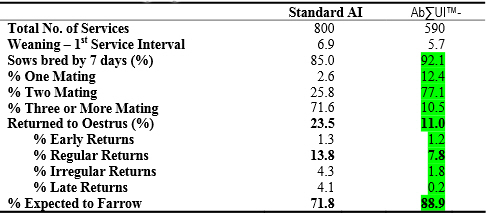



Comparison of Swine AI Procedures Between Traditional Cervical Catheters and a New Model of Hydraulic IUI under Field Conditions
An experiment in Thailand reveals better results for artificial insemination of sows using a new catheter from Absolute Swine Insemination Co. than a conventional foam-tipped catheter; more sows were bred by seven days using two doses with the new catheter than with three doses using the foam device.Standard artificial insemination (AI) is used in swine farms worldwide and most of them use traditional cervical AI catheters, according to D. Laohasinnarong and K. Kaeoket from Mahidol University in Nakhon Pathom.
Nowadays, they continue, intra-uterine insemination (IUI) catheters are often used instead of traditional catheters in many parts of the world, and AI procedures using IUI catheters can reduce the number of spermatozoa per dose. However, some previous reports showed there were factors that could lead to unsuccessful of use of traditional IUI catheters with reduced dosage.
Manufacturers are constantly trying to produce new models of IUI catheters. One modern concept used for this study is a safe IUI catheter that uses a patented hydraulic injection insemination system, Ab∑UI™ from Absolute Swine Insemination Co., LLC (ASIC).
The aim of this study was to evaluate the service efficiency using the new model of Ab∑UI-IUI catheters compared to the previous AI procedures using traditional cervical catheters.
Materials and Methods
There were two groups of crossbred sows, totalling 1,390 sows, for this study, which was conducted under field conditions in a commercial swine farm in Ratchaburi province, Thailand, for a period of 20 weeks and individually allocated to gestation crates.
Water was provided ad libitum all day.
Group 1 was pre-experimental group, 800 sows (average parity 2.3), for 12 weeks. Group 2 was experimental group, 590 sows (average parity 2.4), for eight weeks.
Oestrus detection was performed twice daily beginning after weaning and the animals were artificially inseminated after detecting heat.
Pre-experimental groups used standard AI procedures by using traditional catheters. The experimental group used ASIC Ab∑UI-catheters.
Serviced data was collected from PigLIVE®, pig farm management software, for comparison and evaluation.
Results
The return rate in the 800 sows of pre-experimental group was 23.5 per cent compared with 11.0 per cent in the 590 sows of experimental group using IUI technique.
Other results from both groups are summarised and shown in Table 1.

Discussion and Conclusions
This study showed the ASIC Ab∑UI-injection technique can improve service efficiency. Previous service efficiency data showed that the returned rate was 23.5 per cent but after using the new ASIC IUI catheters the returned rate was decreased to 11.0 per cent.
Regular returns were reduced also.
Service efficiency improved and led to increasing percentage expected to farrow from 71.8 per cent to 88.9 per cent.
For number of mating per heat, 77.1 per cent of Ab∑UI- sows received two doses compared to 71.6 per cent of the standard AI group being serviced three or more times.
The results show that two inseminations per heat is enough if producers use this new Ab∑UI-technique, follow good farm management, and properly understand the timing of oestrus relative to ovulation.
This new model of Ab∑UI-catheters uses the Ab∑UI-/DIUI concept. ASIC’s Ab∑UI- model uses a hydraulic injection insemination system with a latex membrane inside the catheter. When users squeeze the semen bottle for pushing sperm into the female genitals, the latex membrane safely extends and gently enters directly into the uterus. This concept will not cause damage to the uterus mucosa as other IUI catheters can.
Therefore, ASIC’s catheters could be use as a safer IUI catheter in swine farms.
Acknowledgement: The authors thank Absolute Swine Insemination Co., LLC who provided their new model hydraulic Ab∑UI™-catheters for this study.







